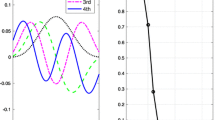Abstract
Blind source separation (BSS) techniques are increasingly being applied to the analysis of biomedical signals in general and electroencephalographic (EEG) signals in particular. The analysis of the long-term monitored epileptiform EEG presents characteristic problems for the implementation of BSS techniques because the ongoing EEG has time varying frequency content which can be both slowly varying and yet also include short bursts of neurophysiologically meaningful activity. Since statistically based BSS methods rely on sample- estimates, which generally require larger window sizes, these methods may extract neurophysiologically uninformative components over short data segments. Here we show that BSS techniques using signal time structure succeed in extracting neurophysiologically meaningful components where their statistical counterparts fail. To this end we use an algorithm that extracts linear mixtures of nonstationary sources, without pre- whitening, through joint diagonalisation of a number of windowed, lagged cross-covariance matrices. We show that this is extremely useful in tracking seizure onset in the epileptiform EEG.
Preview
Unable to display preview. Download preview PDF.
Similar content being viewed by others
References
Hyvärinen, A., Karhunen, J., Oja, E.: Independent component analysis. J. Wiley and Sons, New York (2001)
Roberts, S., Everson, R.: Independent component analysis: principles and practice. Cambridge University Press, Cambridge (2001)
James, C.J., Lowe, D.: ICA in Electromagnetic Brain Signal Analysis. In: Proc. Int. Conf. on Neural Networks and Expert Systems in Medicine and Healthcare (NNESMED 2001), Milos Island, Greece, pp. 197–202 (2001)
Hyvärinen, A., Oja, E.: A fast fixed-point algorithm for independent component analysis. Neural Computation 9, 1483–1492 (1997)
James, C.J., Gibson, O.J.: Temporally Constrained ICA: an Application to Artifact Rejection in Electromagnetic Brain Signal Analysis. IEEE Transactions on Biomedical Engineering 50(9), 1108–1116 (2003)
Ziehe, A., Müller, K.-R.: TDSEP - an efficient algorithm for blind separation using time structure. In: Proc. Int. Conf. on Artificial Neural Networks (ICANN 1998), Skovde, Sweden. pp. 675-680 (1998)
Belouchrani, A., Amin, M.G.: Blind source separation based on time-frequency signal representations. IEEE Trans. Signal Processing 46(11), 2888–2897 (1998)
Choi, S., Cichocki, A., Belouchrani, A.: Second order nonstationary source separation. Journal of VLSI Signal Processing 32, 93–104 (2002)
Ziehe, A., Laskov, P., Müller, K.-R., Nolte, G.: A linear least-squares algorithm for joint diagonalization. In: Proc. Int. Conf. on Independent Component Analysis and Blind Signal Separation (ICA 2003), Nara, Japan. pp. 469–474 (2003)
Belouchrani, A., Abed-Meraim, K., Cardoso, J.-F., Moulines, E.: A blind source separation technique using second order statistics. IEEE Trans. Signal Processing 45(2), 434–444 (1997)
Author information
Authors and Affiliations
Editor information
Editors and Affiliations
Rights and permissions
Copyright information
© 2004 Springer-Verlag Berlin Heidelberg
About this paper
Cite this paper
James, C.J., Hesse, C.W. (2004). A Comparison of Time Structure and Statistically Based BSS Methods in the Context of Long-Term Epileptiform EEG Recordings. In: Puntonet, C.G., Prieto, A. (eds) Independent Component Analysis and Blind Signal Separation. ICA 2004. Lecture Notes in Computer Science, vol 3195. Springer, Berlin, Heidelberg. https://doi.org/10.1007/978-3-540-30110-3_129
Download citation
DOI: https://doi.org/10.1007/978-3-540-30110-3_129
Published:
Publisher Name: Springer, Berlin, Heidelberg
Print ISBN: 978-3-540-23056-4
Online ISBN: 978-3-540-30110-3
eBook Packages: Springer Book Archive




